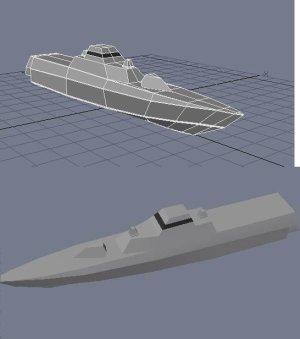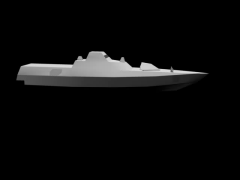OmniMower
Codename Synrise
This is the thread covering the on going work of the Visby Class Corvette.
The 3D model work an the forthcoming animations are made by Fredrik Alfredsson. And there is no doubt that it will be of HiQ!
Here is a lil info for those who are interested....
The Visby Class Stealth Corvette
Gone are the days when the mere firepower of a ship was sufficient for its own protection. The concept today is action before - or even without - being detected.
The Visby Class corvette is the first vessel in the world to have fully developed stealth technology, combined with high operational versatility. The outstanding stealth properties fundamentally change the ship's survivability and improve its mission effectiveness.
Visby is a flexible surface combatant, designed for a wide range of roles: anti-surface warfare (ASuW), anti-submarine warfare (ASW), mine countermeasures (MCM), patrol and much more.
The stealth programme
In 1986 the Swedish Defence Material Administration (FMV) initiated the development of a stealth test platform, HMS Smyge. It was launched in 1991 and used for testing stealth characteristics in all possible aspects. This formed the basis for the YS 2000 project - the Visby Class corvette.
The Visby is designed to minimize all signatures - optical and infrared signature, above water acoustic and hydroacoustic signature, underwater electrical potential and magnetic signature, pressure signature, radar cross section and actively emitted signals.
The difference in detection range between an ordinary vessel and Visby creates a considerable zone where the Visby can see but not be seen. The advantage zone.
Combat management
All missions are supported by CETRIS - the real-time command, control, communication, intelligence and interoperability system (C4I2). The system is modular and open, and allows for integration of future technologies, without expensive changes.
Anti-surface warfare
The Visby is designed for the installation of a surface-to-surface missile (SSM) system. On the Swedish version, eight SSM (RBS15 MkII) can be fully integrated into the hull and covered with smart rapid hatches.
Air defence system
The air defence system (ADS) is totally integrated, and it dynamically, automatically and simultaneously calculates and performs hard-kill as well as soft-kill engagements.
The active part of the ADS consists of the Bofors 57 mm multi-purpose gun, with a new, stealth cupola designed as an integrated part of the hull structure.
The Visby is designed for the installation of an air defence missile system (SAM), fully integrated into the aft part of the vessel.
The ADS also includes the ESM and various electronic countermeasures.
Mine countermeasures
The MCM system consists of a combination of extremely low signatures, sensors and weapons, and very high shock resistance.
For detecting and classifying mines, the Visby uses ROVs (remotely operated vehicles).
Anti-submarine warfare
A powerful sonar system is used to detect, locate, classify and supply real-time target data to the weapons.
In addition, the sonar-equipped ROV-S can be launched for surveillance and classification of targets.
The Visby is equipped with wire-guided, homing 40 cm torpedoes. A submarine can also be attacked with an ROV-E or the brand-new 5" ASW multiple rocket system.
Hull design - attention to every detail
The hull is designed on stealth principles with large flat angled surfaces. Every feature that need not necessarily be located outside the hull has been built in or concealed under specially designed hatches. The gas turbine exhausts have been concealed in hidden outlets close to the water surface at the stern of the vessel.
The vessel is built of sandwich-construction carbon fibre reinforced plastic (CFRP). The material provides high strength and rigidity, low weight, good shock resistance, low radar signature and low magnetic signature.
The material dramatically reduces the structural weight (typically 50% of a conventional steel hull). This results in a higher payload carrying capability, higher speed or longer range.
The first Visby Corvette were put into the sea June 2000.
Main Arment
- one 57mm Bofors All-Target Gun
- eight RBS15 Advanced SSM
- Torpedoes
- Anit-Sub grenades
Is Prepared for:
- heavy Torpedoes
- AA Missile systems
The 3D model work an the forthcoming animations are made by Fredrik Alfredsson. And there is no doubt that it will be of HiQ!
Here is a lil info for those who are interested....
The Visby Class Stealth Corvette
Gone are the days when the mere firepower of a ship was sufficient for its own protection. The concept today is action before - or even without - being detected.
The Visby Class corvette is the first vessel in the world to have fully developed stealth technology, combined with high operational versatility. The outstanding stealth properties fundamentally change the ship's survivability and improve its mission effectiveness.
Visby is a flexible surface combatant, designed for a wide range of roles: anti-surface warfare (ASuW), anti-submarine warfare (ASW), mine countermeasures (MCM), patrol and much more.
The stealth programme
In 1986 the Swedish Defence Material Administration (FMV) initiated the development of a stealth test platform, HMS Smyge. It was launched in 1991 and used for testing stealth characteristics in all possible aspects. This formed the basis for the YS 2000 project - the Visby Class corvette.
The Visby is designed to minimize all signatures - optical and infrared signature, above water acoustic and hydroacoustic signature, underwater electrical potential and magnetic signature, pressure signature, radar cross section and actively emitted signals.
The difference in detection range between an ordinary vessel and Visby creates a considerable zone where the Visby can see but not be seen. The advantage zone.
Combat management
All missions are supported by CETRIS - the real-time command, control, communication, intelligence and interoperability system (C4I2). The system is modular and open, and allows for integration of future technologies, without expensive changes.
Anti-surface warfare
The Visby is designed for the installation of a surface-to-surface missile (SSM) system. On the Swedish version, eight SSM (RBS15 MkII) can be fully integrated into the hull and covered with smart rapid hatches.
Air defence system
The air defence system (ADS) is totally integrated, and it dynamically, automatically and simultaneously calculates and performs hard-kill as well as soft-kill engagements.
The active part of the ADS consists of the Bofors 57 mm multi-purpose gun, with a new, stealth cupola designed as an integrated part of the hull structure.
The Visby is designed for the installation of an air defence missile system (SAM), fully integrated into the aft part of the vessel.
The ADS also includes the ESM and various electronic countermeasures.
Mine countermeasures
The MCM system consists of a combination of extremely low signatures, sensors and weapons, and very high shock resistance.
For detecting and classifying mines, the Visby uses ROVs (remotely operated vehicles).
Anti-submarine warfare
A powerful sonar system is used to detect, locate, classify and supply real-time target data to the weapons.
In addition, the sonar-equipped ROV-S can be launched for surveillance and classification of targets.
The Visby is equipped with wire-guided, homing 40 cm torpedoes. A submarine can also be attacked with an ROV-E or the brand-new 5" ASW multiple rocket system.
Hull design - attention to every detail
The hull is designed on stealth principles with large flat angled surfaces. Every feature that need not necessarily be located outside the hull has been built in or concealed under specially designed hatches. The gas turbine exhausts have been concealed in hidden outlets close to the water surface at the stern of the vessel.
The vessel is built of sandwich-construction carbon fibre reinforced plastic (CFRP). The material provides high strength and rigidity, low weight, good shock resistance, low radar signature and low magnetic signature.
The material dramatically reduces the structural weight (typically 50% of a conventional steel hull). This results in a higher payload carrying capability, higher speed or longer range.
The first Visby Corvette were put into the sea June 2000.
Main Arment
- one 57mm Bofors All-Target Gun
- eight RBS15 Advanced SSM
- Torpedoes
- Anit-Sub grenades
Is Prepared for:
- heavy Torpedoes
- AA Missile systems


 You have to put your cat into a safe place....and maybe you could take a pic so we also can see his/shes unimpressed lil smile...
You have to put your cat into a safe place....and maybe you could take a pic so we also can see his/shes unimpressed lil smile...


 (seriously, if you chopped off the back end, it's pretty much a star destroyer...)
(seriously, if you chopped off the back end, it's pretty much a star destroyer...)
